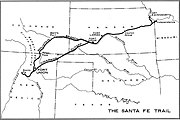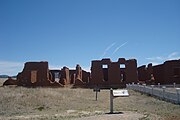Fort Union National Monument
| Fort Union National Monument | |
|---|---|
 Fort Union Ruins | |
| Location | Mora County, New Mexico, U.S. |
| Nearest city | Watrous, New Mexico |
| Coordinates | 35°54′25″N 105°00′54″W / 35.907°N 105.015°W[1] |
| Area | 720.6 acres (291.6 ha)[2] |
| Established | June 28, 1954 |
| Visitors | 9,570 (in 2023)[3] |
| Governing body | National Park Service |
| Website | Fort Union National Monument |
Fort Union National Monument | |
| Built | 1851 |
| NRHP reference No. | 66000044[4] |
| NMSRCP No. | 61 |
| Significant dates | |
| Added to NRHP | October 15, 1966 |
| Designated NMSRCP | May 23, 1969 |
Fort Union National Monument is a unit of the United States National Park Service located 7.7 miles north of Watrous in Mora County, New Mexico.
The site preserves the remains of three forts that were built starting in the 1850’s. Also visible at Fort Union and from the road leading to it are ruts from the Mountain and Cimarron Branches of the old Santa Fe Trail.
The National Monument has a visitor center containing a historical museum and showing a film about the fort’s history. A self-guiding trail leads through remains of the second and third forts. Ruins of the ordnance depot and site of the first fort are visible across the valley to the west.
The National Monument is open 8:00 a.m. to 4:00 p.m. throughout the year except Thanksgiving (fourth Thursday of November), Christmas Day (December 25) and New Year’s Day (January 1). Admission is free.
Description by William Davis[edit]
Santa Fe trader and author William Davis gave his first impression of the fort in the year 1857:
Fort Union, a hundred and ten miles from Santa Fé, is situated in the pleasant valley of the Moro. It is an open post, without either stockades or breastworks of any kind, and, barring the officers and soldiers who are seen about, it has much more the appearance of a quiet frontier village than that of a military station. It is laid out with broad and straight streets crossing each other at right angles. The huts are built of pine logs, obtained from the neighboring mountains, and the quarters of both officers and men wore a neat and comfortable appearance.[5]
History of Fort Union[edit]
This section needs expansion with: some actual history, such as why it was established, what units were garrisoned there, what conflicts it was involved in, etc. You can help by adding to it. (January 2018) |
The treaty ending the U.S.-Mexican War gave the U.S. undisputed control of Texas and ceded to the United States the present-day states of California, Nevada, Utah, most of New Mexico, Arizona and Colorado, and parts of Texas, Oklahoma, Kansas, and Wyoming.
In New Mexico, the U.S. army set up garrisons in settlements to protect the area’s inhabitants and travel routes from raids by Native Americans, but this proved unsatisfactory. Temptations in civilian communities such as alcohol distracted soldiers and often made them unfit for duty.
In April 1851, Lt. Col. Edwin V. Sumner was ordered to revise the defense of the territory. Among his first acts was to break up the garrisons and move them closer to the Indians. He moved his headquarters and supply depot from Santa Fe to near where the Mountain and Cimarron branches of the Santa Fe Trail converged. This was about 25 miles northeast of the town of Las Vegas. There he set up Fort Union.
The first of the three forts built in this valley was begun in August 1851. For a decade it served as the base for military operations in the area and a key station on the Santa Fe Trail, affording travelers a place to rest nearby and refit at the post sutler’s store (where general merchandise not supplied to soldiers by the army was sold). It also became the principal military supply depot of the Southwest.
During the 1850s, the fort’s mounted riflemen (called dragoons) campaigned against several southern Rocky Mountain Indian tribes that were disrupting traffic on the Santa Fe Trail. One of the first campaigns was directed against the Jicarilla Apaches. In 1854 that tribe nearly wiped out a company of dragoons. The Apaches were driven into the mountains west of the Rio Grande and routed. Military operations were also conducted against Utes of southern Colorado in 1855 and Kiowas and Comanches for raiding the plains east of the fort in 1860–61.
Anticipating a Confederate invasion of New Mexico, Col. Edward R.S. Canby, charged with the territory’s defense, concentrated troops at Fort Craig on the Rio Grande near present-day Socorro, and sent its soldiers to patrol the Santa Fe Trail, the main artery of supply for Federal forces. He also ordered construction of the second Fort Union, a star-shaped earthen fortification, to strengthen defenses.
When the Civil War began in April 1861, most of the regular troops (except those officers who joined Confederate forces) were withdrawn from Fort Union and other frontier posts to be sent east. They were replaced by volunteer regiments.
The second fort at the National Monument was designed to defend against a Confederate military invasion coming north up the Rio Grande Valley, from El Paso, Texas. Early in the war such a force was turned back in 1862 by Colorado and New Mexico Volunteers and U.S. Regulars from Fort Union. They fought the Confederates at Glorieta Pass, about 20 miles southeast of Santa Fe. Defeated, the Confederates withdrew to Texas, ending Civil War activity in the Southwest and saving the mines in Colorado from being used as a source of funds for the South. The second Fort Union was abandoned soon afterwards.
The third fort, whose ruins was begun in 1863. With New Mexico securely in Federal hands, the new departmental commander, Brig. Gen. Jame[6]s H. Carleton began its construction. The sprawling installation took six years to complete and was the most extensive in the territory. It included not only a military post but a separate quartermaster depot with warehouses, corrals, shops, offices and living quarters.
The supply function overshadowed that of the military and employed far more men, mostly civilians. An ordnance depot, erected on the site of the first fort at the western edge of the valley, rounded out the complex.
Throughout the 1860s and the 1870s troops from Fort Union took part in operations against Indians. Several relentless campaigns against the Apaches, Navajos, Cheyennes, Arapahos, Kiowas, Utes and Comanches finally brought peace to the southern Plains in the spring of 1875 but on the white man’s terms.
Fort Union’s involvement in the Indian wars had come to an end but its garrison occasionally helped to track down outlaws, quell mob violence, and mediate feuds. The supply depot continued to flourish until 1879, when the Santa Fe Railroad replaced the Santa Fe Trail as the principal means of commerce. By 1891 the fort had outlived its usefulness and was abandoned.
Units assigned to Fort Union and Kit Carson[edit]
The fort served as headquarters of the 8th Cavalry in the early 1870s and as headquarters of the 9th Cavalry in the late 1870s during the Apache Wars. [7] Christopher “Kit” Carson was commander of Fort Union from December 24, 1865 to April 24, 1866. [8]
Land ownership[edit]
In its forty years (1851–1891) as a frontier post, Fort Union had to defend itself in the courtroom as well as on the battlefield. When the United States Army built Fort Union in the Mora Valley in 1851, the soldiers were unaware that they had encroached on private property, which was part of the Mora Grant. The following year Colonel Edwin Vose Sumner expanded the fort to an area of eight square miles by claiming the site as a military reservation. In 1868, President Andrew Johnson declared a timber reservation, encompassing the entire range of the Turkey Mountains (part of the Sangre de Cristo range) and comprising an area of fifty-three square miles, as part of the fort.[9]
The claimants of the Mora Grant immediately challenged the government squatters and took the case to court. By the mid-1850s, the case reached Congress. In the next two decades, the government did not give any favorable decision to the claimants, until 1876 when the Surveyor-General of New Mexico reported that Fort Union was "no doubt" located in the Mora Grant. But the army was unwilling to move to another place or to compensate the claimants because of the cost. The Secretary of War took "a prudential measure", protesting the decision of the acting commissioner of the General Land Office. He argued that the military had improved the area and should not give it up without compensation.[9] This stalling tactic worked; the army stayed at the fort until its demise in 1891, not paying a single penny to legitimate owners.
Gallery[edit]
-
Map of the historic Santa Fe Trail
-
Remainder of buildings along Officer's Row
-
Remainder of the fort's hospital
-
View of the fort from a distance away
See also[edit]
- National Register of Historic Places listings in Mora County, New Mexico
- List of national monuments of the United States
References[edit]
- ^ "Fort Union National Monument". Geographic Names Information System. United States Geological Survey, United States Department of the Interior. Retrieved 2012-12-30.
- ^ "Annual Report of Lands as of September 30, 2011" (PDF). United States Fish and Wildlife Service. Retrieved 2012-12-30.
- ^ "NPS Annual Recreation Visits Report". National Park Service. Retrieved 2012-12-30.
- ^ "National Register Information System". National Register of Historic Places. National Park Service. July 9, 2010.
- ^ William H. Davis, El Gringo − or New Mexico and Her People, Harper & Brothers Publishers, New York 1857 (online at: El Gringo Archived 2006-09-18 at the Wayback Machine), p. 51
- ^ Geologic map of the Fort Union quadrangle, Mora County, New Mexico (Report). US Geological Survey. 1974.
- ^ Schubert, Frank N. (1997). Black valor: buffalo soldiers and the Medal of Honor, 1870-1898. Wilmington, Del: SR Books. ISBN 978-0-8420-2586-7.
- ^ Oliva, Leo E. (1993). Fort Union and the Frontier Army inthe winning of the Southwest : a historic resource study Fort Union National Monument. Professional papers No. 41. Santa Fe, New Mexico: Southwest Cultural Resources Center: Division of History National Park Service Fort Union, New Mexico.
- ^ a b U.S. Congress, Senate, Committee on Military Affairs, "Title to Certain Military and Timber Reservations", Senate Report 621, 45th Congress, 3rd Session, 1879, pp. 3-4
External links[edit]
- National Park Service National Monuments in New Mexico
- Forts in New Mexico
- Museums in Mora County, New Mexico
- Military and war museums in New Mexico
- New Mexico Territory
- Closed installations of the United States Army
- History of Mora County, New Mexico
- 1851 establishments in New Mexico Territory
- 1890s disestablishments in New Mexico Territory
- Forts on the National Register of Historic Places in New Mexico
- Protected areas of Mora County, New Mexico
- Protected areas established in 1954
- 1954 establishments in New Mexico
- National Register of Historic Places in Mora County, New Mexico
- Santa Fe Trail






